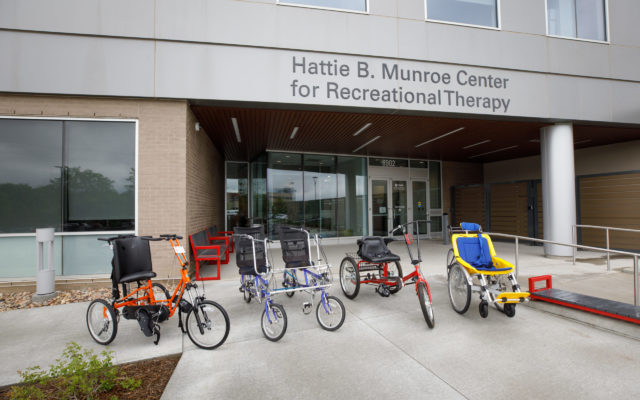Munroe-Meyer Institute celebrates new home

Omaha, NE (June 8, 2021) The Munroe-Meyer Institute cut the ribbon on its new home at 6902 Pine St., near the University of Nebraska at Omaha’s Scott Campus today.
The Munroe-Meyer Institute is a part of the University of Nebraska Medical Center with a mission to be a world leader in helping individuals with disabilities and complex health care needs, their families and the community through outreach, engagement, premier educational programs, innovative research and extraordinary patient care.
The building “is a dream literally come true,” said MMI Director Karoly Mirnics, MD, PhD.
“With this new building, MMI is positioned as never before to support the intellectual and developmental disability (IDD) community as it strives for awareness, acceptance and opportunity,” Dr. Mirnics said. “This building will fuel a palpable change in the IDD community and in the broader community as we work together toward those goals.”
“We created a unique building, the most advanced facility for those families impacted by IDD in the nation,” Dr. Mirnics said. “We wanted to create a new standard in IDD care for families, and we turned to these families – experts in their own right – to discover what they wanted that facility to be.”
UNMC Chancellor Jeffrey P. Gold, MD, called the new building a doorway into the institute’s second century.
“Since its beginning in 1919, Munroe-Meyer Institute has worked to improve the lives of the people and families it serves,” Dr. Gold said. “This new home gives it a much larger space and increased versatility and flexibility, but the core of the MMI mission — partnering with those with intellectual and developmental disabilities and their families to overcome challenges, to live fuller, richer lives — remains the same. We are forever grateful to all of the private philanthropists from our community who have invested in this world-class facility and the MMI mission.
“All of UNMC is excited to see how our colleagues at MMI will continue to grow in their new home to provide even more effective clinical care, education and research, all in the name of enhancing the lives of the people and families they serve.”
Costs for the building initiative were more than $90 million with funding provided through the state of Nebraska and private gifts to the University of Nebraska Foundation.
“Due in large part to the philanthropic generosity of those who saw the need and value, many families will benefit from the excellent care and expanded services now possible through the Munroe-Meyer Institute in its new home,” said Brian Hastings, president and CEO of the University of Nebraska Foundation. “Thank you to our benefactors for the dream they’ve made possible and to the faculty, staff and providers for delivering this life-changing care to our families.”
Major contributors to the building initiative include the following:
- Weitz Family Foundation
- William and Ruth Scott Family Foundation
- Suzanne & Walter Scott Foundation
- Hattie B. Munroe Foundation
- Clarkson Regional Health Services
- Holland Foundation
- Robert B. Daugherty Foundation
- The Lozier Foundation
The new building is more than double the size of MMI’s former home, providing room for growth of existing programs and the development of new ones, ample parking, entrances and a floor plan designed to accommodate the needs of the individuals MMI serves.
“Our goal is that every person or caregiver that comes through our door will find what they need,” Dr. Mirnics said. “This new building will allow us to provide them with the extraordinary care and growth opportunities to meet their goals throughout their life.”
Dr. Mirnics said MMI has a “passionate commitment” to its mission and the families it serves.
“Although it’s wonderful, the building is, in the end, only a building,” Dr. Mirnics said. “What is most important is what the building will allow us to provide – the best, most comprehensive, most integrated family-centric care for IDD in the world. And we will be doing that in MMI’s new home for decades to come.”








